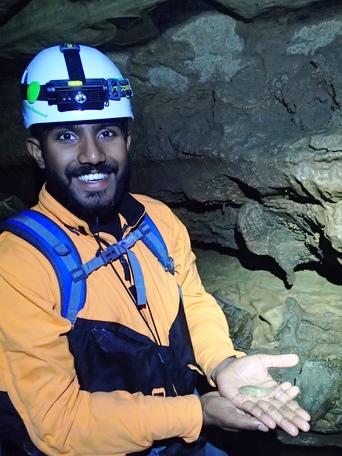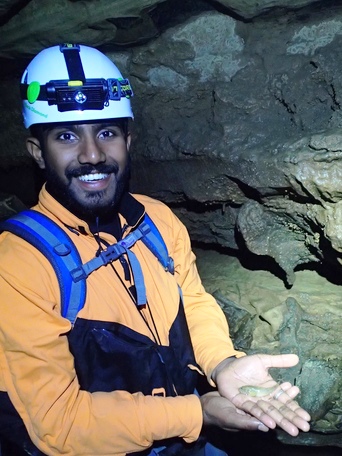
Xplor reconnects kids to nature and helps them find adventure in their own backyard. Free to residents of Missouri.


































Stay in Touch with MDC news, newsletters, events, and manage your subscription

Xplor reconnects kids to nature and helps them find adventure in their own backyard. Free to residents of Missouri.

A monthly publication about conservation in Missouri. Started in 1938, the printed magazine is free to residents of Missouri.


PERRYVILLE, Mo. -- The title fisheries research assistant might not sound exciting on its own, but to Sindupa De Silva and Wesley Sleeper there’s more to the job than the title represents. They work for the Missouri Department of Conservation (MDC) to help manage Missouri caves, which is an experience they enjoy.
“Imagine being on a planet like earth but there’s no light, except for your headlight or flashlight. Its eerily quiet, all you hear is the flowing water and water dripping from stalactites to stalagmites,” De Silva said. “Some places it seems like you’re walking – and sometimes crawling - down a tunnel, others it’s like being in a cathedral.”
De Silva described the thrill of the unknown and knowing that he’s deep underground without any form of communication to the outside world as very exciting aspects of his job.
Sleeper agreed with De Silva that working in caves is a unique and fun experience.
“Being in a cave is like entering a different world,” he said. “They’re dark, humid, and full of sights and organisms that simply cannot be seen above ground.”
These two MDC research assistants aren’t just going into caves for fun. They’re part of a team of researchers collecting information for MDC’s Grotto Sculpin Population Study. Part of their job is to look at microhabitats, a tiny portion of habitat, in the underwater stream system and to collect grotto sculpin to improve understanding of the current status of the endangered fish. Grotto sculpins are small cave-dwelling fish that live in and around five cave systems and two surface streams in Perry County. Like their more pigmented relatives, the banded sculpin, they are bottom-dwellers.
“We study the numbers and sizes of the sculpin in different caves,” Sindupa said. “Then we observe any trends in the numbers and sizes over seasons and years and look for any changes in the environment, such as the water quality and sediment.”
This information is valuable in helping biologists make decisions that protect the species. Land use around sinkholes has a profound impact on ground water quality and grotto sculpin health because sinkholes supply water to cave streams and groundwater sources.
Jason Crites is the MDC fisheries management biologist who leads the grotto sculpin research team. He said De Silva and Sleeper both had to have a background in math and science in order to pursue their career.
“They have a good understanding of fish species identification and fish sampling techniques,” he said. “They have to use and calibrate various instruments needed in the collection of data such as flow meters, turbidity meters, cameras and seines, and they also must have physical and mental toughness. Working in confined dark spaces is not for everyone and they are exceptional.”
Physical and mental toughness are important because of the rugged terrain below ground and the strength that’s required to move in those dark and sometimes very confined conditions.
Crites said the team’s work is very important because managing Missouri’s wildlife, whether above or below ground, is the mission of the agency. Caves are very sensitive environments and can show signs of problems based on what’s occurring above ground.
“Changes in wildlife populations below ground can be an indicator of a much bigger problem, so protecting grotto sculpin and managing the wildlife in caves helps us to improve conditions above ground that affect both environments,” Crites said.
De Silva said working in caves has given him an appreciation of what he and others can do above ground to help the wildly weird wildlife underground.
“Our actions can have an influence on cave life,” he said. “We have to be aware that trash can easily end up in these caves and release contaminants which can harm the endangered grotto sculpin and other wildlife.”
Sleeper asks that people be cautious of entering caves, as they’re fragile and sometimes dangerous environments.
“I would ask folks to treat caves with respect and if they would decide to enter one, be careful where they step,” he said. “You never know what could be under the rocks.”
The two recommend volunteering with trash removal and stream team groups to help clean up above ground and they both say they hope to continue their careers in conservation for many years to come.
More information about cave life, conservation careers and stream team volunteering opportunities, is available at mdc.mo.gov.